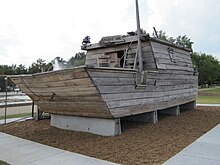Flatboat
Photo credit: wikipedia
From 1800-1814, French fur traders established a healthy business by going up the river with whatever trade goods appealed to the native tribes, exchanging them for furs, which they brought south for shipment mainly to Europe. The age of the steamboat began to dawn about 1814. Until then, river cargo was handled mostly upstream by canoe or pirogues (hollowed out logs), and downstream in flatboats and keelboats. The latter two were temporary vessels intended to last only long enough to deliver the freight down river. They were then broken up for building materials or scrap.
Two keelboats, one being poled and one under sail, passing a flatboat.
Photo credit: wikipedia
Jean Pierre Chouteau and his brother Auguste (a graduate of the recently established West Point Military Academy), were French Creole fur traders, merchants, and later, politicians, who amassed both wealth and influence through the new Louisiana territory from New Orleans to St. Louis and west. As early as 1796, Jean Pierre had established an alliance with several thousand Osage that called for them to move to the Three Forks area to develop a fur trade there. In 1802, Jean Pierre established the first trading post and permanent white settlement along the Arkansas River in Oklahoma at the junction of the Neosho River (previously called the Grand River) and Saline Creek, which is now Salina, OK. Indians boiled water from a spring south of the post to obtain salt, and Chouteau obtained the salt springs in 1825 through a treaty with the Osage, and turned the property around in 1830 when he sold the springs to Sam Houston, a friend of Washington Irving. In 1819, Auguste Chouteau established a boatyard at the Three Forks, near Fort Gibson, or present-day Muskogee, OK. Boats from his yard were 50-60 feet long, and could carry 50 tons of freight.
I found a historical disagreement concerning the Chouteau’s. One source credits Jean Pierre with establishing Salina, another gives the credit to Auguste. I’m not a historian, but everything seems to say Jean Pierre was in the area first, so I’d lean his way. Since they were both eventually there and working together, it probably doesn’t make much difference. Also, there’s enough credit to go around. After all, it was their father, Rene A. Chouteau, who had founded St. Louis. Across the Neosho River from Salina, and a bit southwest, is the town of Chouteau, OK, also named for the brothers. It was originally a cattle town made prosperous by the Katy railroad starting in 1871, and called Cody Creek after a stream that flowed north of town. Both the name of the creek and the town were changed to Chouteau, again reflecting the wealth and influence the family was amassing along the upper Three Forks area. Jean Pierre’s son, August Pierre, called A.P., continued the family business in Salina and established another post along the Verdigris River and others along the Mississippi. His son, Pierre, who was called Cadet, continued the expanding business until around 1850, by which time the railroads had created a steady decline in river trade. He then moved to New York to diversify the family’s wealth into steamboats, railroads, and mining.


No comments:
Post a Comment